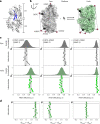Reliability and accuracy of single-molecule FRET studies for characterization of structural dynamics and distances in proteins
- PMID: 36973549
- PMCID: PMC10089922
- DOI: 10.1038/s41592-023-01807-0
Reliability and accuracy of single-molecule FRET studies for characterization of structural dynamics and distances in proteins
Abstract
Single-molecule Förster-resonance energy transfer (smFRET) experiments allow the study of biomolecular structure and dynamics in vitro and in vivo. We performed an international blind study involving 19 laboratories to assess the uncertainty of FRET experiments for proteins with respect to the measured FRET efficiency histograms, determination of distances, and the detection and quantification of structural dynamics. Using two protein systems with distinct conformational changes and dynamics, we obtained an uncertainty of the FRET efficiency ≤0.06, corresponding to an interdye distance precision of ≤2 Å and accuracy of ≤5 Å. We further discuss the limits for detecting fluctuations in this distance range and how to identify dye perturbations. Our work demonstrates the ability of smFRET experiments to simultaneously measure distances and avoid the averaging of conformational dynamics for realistic protein systems, highlighting its importance in the expanding toolbox of integrative structural biology.
© 2023. The Author(s).
Conflict of interest statement
T.D.C. and A.N.K. are founders of different companies selling single-molecule fluorescence microscopes (Exciting Instruments, Oxford Nanoimager). The other authors declare no competing interests.
Figures






References
-
- Algar WR, Hildebrandt N, Vogel SS, Medintz IL. FRET as a biomolecular research tool—understanding its potential while avoiding pitfalls. Nat. Methods. 2019;16:815–829. - PubMed
-
- Hildebrandt, N. in FRET—Förster Resonance Energy Transfer (eds Medintz, I. & Hildebrandt, N.) 105–163 (Wiley, 2013).
-
- Muschielok A, et al. A nano-positioning system for macromolecular structural analysis. Nat. Methods. 2008;5:965–971. - PubMed
Publication types
MeSH terms
Substances
Grants and funding
- R01 GM130942/GM/NIGMS NIH HHS/United States
- ERXC ADG Multiorganelldesign/ERC_/European Research Council/International
- 110164/Z/15/Z/WT_/Wellcome Trust/United Kingdom
- BB/T008032/1/BB_/Biotechnology and Biological Sciences Research Council/United Kingdom
- GM122569/NH/NIH HHS/United States
- ERC-StG 638536-SM-IMPORT/ERC_/European Research Council/International
- WT_/Wellcome Trust/United Kingdom
- R35 GM122569/GM/NIGMS NIH HHS/United States
- 101029907/MCCC_/Marie Curie/United Kingdom
- 681891 (Prosint)/ERC_/European Research Council/International
- grant No. 671208 (hybridFRET)/ERC_/European Research Council/International

